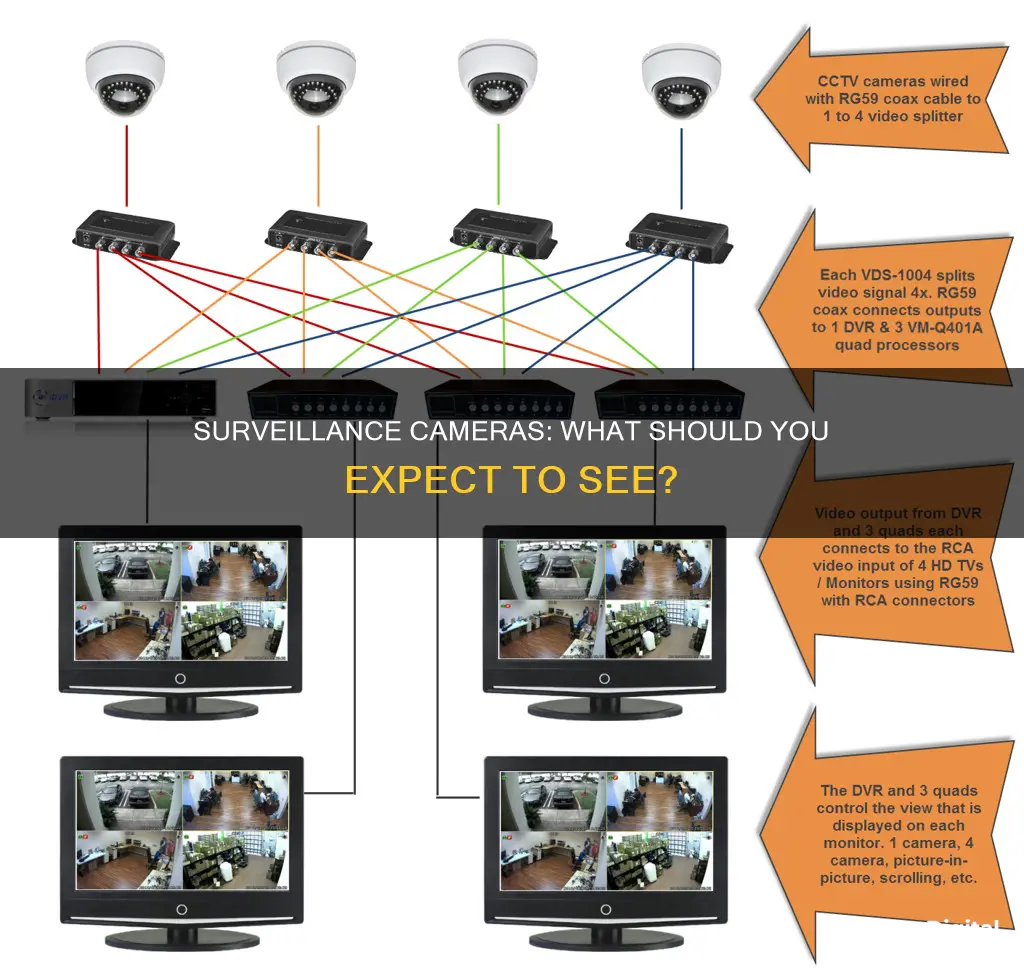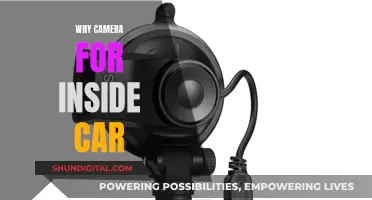
Surveillance cameras are an increasingly common feature of modern life, but what exactly are they hoping to achieve?
Surveillance cameras are typically used to monitor the behaviour and activities of people, with the aim of influencing, managing, directing, or protecting them. They can also be used to monitor facilities or places from a distance. The use of surveillance cameras is often justified as a beneficial and economical method of ensuring security for people, buildings, and valuables.
The expected outputs of surveillance cameras, therefore, are improved security and situational awareness. This can be achieved through the real-time or recorded data that surveillance cameras provide, which can be used for incident prevention, detection, and investigation, and to optimise operations.
Surveillance cameras are often equipped with Input/Output (I/O) ports, which can be used to integrate devices and functions not supported out of the box. For example, I/O ports can be used to connect to photocells, PIR sensors, or magnetic contacts, which can then trigger certain events such as alarms, lights, or notifications.
The use of surveillance cameras is not without controversy, however. Some people feel that surveillance cameras are an invasion of privacy, and there are concerns about the potential for abuse and the lack of control or limits on their use. There are also questions over the effectiveness of surveillance cameras in preventing crimes and the high cost of implementation and maintenance.
What You'll Learn
- Surveillance cameras can improve public safety and reduce crime rates
- They can be used to monitor traffic and provide real-time reports
- They can help catch criminals and gather evidence
- They can be integrated with other systems like access control and IoT
- They can be used for remote monitoring through smart devices

Surveillance cameras can improve public safety and reduce crime rates
Surveillance cameras are an increasingly common feature of modern life, with millions of closed-circuit television (CCTV) cameras installed worldwide. While some people feel more secure with their presence, others feel that their ubiquity invades their privacy.
Improving Public Safety
Surveillance cameras can improve public safety by deterring crime and helping to catch criminals. The presence of cameras can make people feel safer when going about their daily lives, whether that's clubbing, shopping, or travelling. If a suspicious individual or item is spotted, the authorities can be alerted and the area cleared as a precaution.
Reducing Crime Rates
The installation of surveillance cameras has been linked to reduced crime rates. In Humboldt Park, for example, crime incidents dropped by 20% after security cameras were put in place. In Orange County, New Jersey, surveillance cameras showed a 50% drop in all types of crime. In Baltimore and Chicago, cameras were linked to reduced crime, even beyond the areas with camera coverage.
Solving Crimes
Surveillance cameras can also help solve crimes by providing evidence. In the case of the Boston Marathon bombing, investigators were able to identify suspects by sifting through video images captured by the city's cameras. Similarly, it only took the FBI three days to release blurry shots of two suspects in the case of the Boston Marathon bombing, thanks to a surveillance camera installed in a department store.
Weighing the Benefits and Drawbacks
While surveillance cameras can have benefits for public safety and crime reduction, there are also potential drawbacks. Some people feel that surveillance cameras invade their privacy, particularly when placed in areas where there is a reasonable expectation of privacy, such as bathrooms or changing rooms. There are also concerns about the potential for abuse, the effectiveness of the cameras, and the cost of implementing and maintaining such systems.
To balance these concerns, it is important to have guidelines in place to ensure responsible use of surveillance cameras. This includes considering privacy issues when creating surveillance policies, avoiding or masking inappropriate views of private areas, documenting and publicizing policies governing the use of surveillance cameras, and providing training and accountability for law enforcement officers.
Focusing on Infinity: Landscape Photography Camera Techniques
You may want to see also

They can be used to monitor traffic and provide real-time reports
Surveillance cameras are an effective tool for monitoring traffic and enhancing safety on the roads. They can be placed at intersections, roads prone to congestion, or areas with extreme weather conditions to provide a comprehensive view of traffic flow. These cameras are often mounted on poles, bridges, or other structures to capture images or videos of the surrounding areas.
One of the key advantages of surveillance cameras in traffic monitoring is their ability to provide real-time data and improve situational awareness. The cameras are connected to a control centre where authorised personnel can view the footage in real time. This enables them to monitor traffic flow, detect accidents, and take appropriate action promptly. For instance, if a car is pulled over, the cameras can send live alerts to transportation officials, enabling them to assess the situation and dispatch assistance if needed.
Surveillance cameras also aid in reducing traffic incidents and accidents. They act as a deterrent for traffic rule violations, encouraging drivers to follow regulations and speed limits. Additionally, the recorded footage from these cameras can be crucial in determining liability in the event of accidents.
Another benefit of surveillance cameras is their ability to assist in traffic crime prevention and investigation. They can be placed at known hotspots for traffic violations or illegal dumping, helping law enforcement agencies prevent and solve crimes. The cameras can also be equipped with license plate recognition technology, enabling the identification of vehicles involved in criminal activities.
Furthermore, surveillance cameras contribute to enhanced data gathering for traffic management and planning. By monitoring traffic flow, peak hours, and accident-prone areas, transportation departments can make informed decisions about road development and construction. This data can also be used to improve traffic management strategies and create new road projects to alleviate congestion.
In summary, surveillance cameras play a vital role in monitoring traffic, providing real-time data, enhancing safety, and improving traffic flow. They offer multiple benefits, including crime prevention, improved data gathering, and reduced traffic incidents. By utilising this technology, authorities can make informed decisions and take prompt action to ensure the safety of motorists and pedestrians.
Surveillance Cameras: Mounting for Optimal Coverage and Security
You may want to see also

They can help catch criminals and gather evidence
Surveillance cameras are an invaluable tool for law enforcement, aiding in the process of catching criminals and gathering evidence. They provide a clear and objective view of incidents, which can be instrumental in corroborating or even replacing eyewitness accounts, which are often unreliable. The footage from these cameras offers a detailed, frame-by-frame account of events, which serves as powerful evidence in investigations and legal proceedings. This visual evidence is often seen as irrefutable in court, making it challenging for judges and juries to dispute its authenticity.
The use of surveillance cameras has revolutionised the way law enforcement operates, becoming an indispensable part of modern policing. They are typically placed in public spaces and on private properties to monitor activity and capture footage that can be used as evidence. One of their key benefits is the ability to deter criminal activity by making potential criminals feel monitored and less likely to engage in illegal behaviour. This can lead to a reduction in crime rates and safer communities.
Surveillance cameras with facial recognition and license plate recognition capabilities are especially useful for law enforcement. These cameras capture layers of information, helping to identify suspects and track their movements. For example, license plate recognition (LPR) cameras recognise number plates, capture images of the digits, and convert them to text. This provides investigators and officers with additional information about drivers, aiding in their investigations.
In addition, surveillance cameras provide real-time monitoring of public spaces, allowing law enforcement to respond quickly to incidents and potentially stop crimes in progress. They can also be used to create timelines of events leading up to a crime, helping to piece together the sequence of events and identify suspects. This was notably the case in the Boston Marathon Bombing, where surveillance cameras captured footage of the suspects, aiding in their identification and eventual capture.
The successful use of surveillance cameras in high-profile investigations, such as the Boston Marathon Bombing, has prompted many cities to invest in and expand their use of this technology. However, it is important for law enforcement and property owners to use these cameras responsibly and in compliance with legal regulations to respect privacy and civil liberties.
Surveillance at Dollar Tree: Are You Being Watched?
You may want to see also

They can be integrated with other systems like access control and IoT
Surveillance cameras can be integrated with other systems like access control and IoT to enhance security and improve operational efficiency. This integration allows for centralised management of security measures, including video surveillance, access control, and IoT devices.
For example, by connecting surveillance cameras to access control systems, organisations can monitor who is entering and leaving a building in real time. This not only enhances security but also helps in tracking stock movement and employee behaviour. In case of an incident, the relevant footage can be quickly accessed, as the video surveillance and access control systems are synced. This improves the speed of investigations and reduces the time needed to review associated video footage.
Integrating surveillance cameras with IoT devices, such as motion sensors, smoke detectors, and alarms, enables smart security systems that can detect and interpret incidents autonomously. These systems can alert operators and even take pre-programmed actions, such as sending alerts to authorities, activating sprinklers, or locking doors. IoT-connected cameras can also be monitored remotely, allowing security professionals to quickly assess security alerts and false alarms without having to be physically present at the site.
Additionally, the data collected by IoT devices and surveillance cameras can be combined to gain valuable insights. For instance, facility management can be improved by analysing patterns and trends in motion tracking and heat maps. This helps optimise space utilisation and enhance overall space management.
However, integrating surveillance cameras with other systems also comes with challenges, especially regarding cybersecurity. IP surveillance cameras have become a top target for hackers due to their high computing power and good internet traffic throughput. Therefore, it is crucial to implement robust security measures, such as enforcing the changing of default credentials, applying secure boot protocols, and regularly updating firmware.
Mastering Auto Focus: The Magic Behind Sharp Camera Images
You may want to see also

They can be used for remote monitoring through smart devices
Surveillance cameras can be used for remote monitoring through smart devices, allowing users to keep an eye on their homes or businesses from anywhere. This can be done through a companion app or, in some cases, a web portal. Many surveillance cameras also offer two-way communication, allowing users to not only listen in but also talk to people or pets through the camera.
Most smart home security cameras are wireless and connect to Wi-Fi, although some incorporate separate home automation networking standards such as Zigbee or Z-Wave. Some cameras also have Bluetooth for local control and easier setup through a smartphone.
Surveillance cameras with smart home integration can be used with voice commands through Amazon Alexa or Google Assistant. Some cameras also work with Apple HomeKit, which is less common than Google Home and Alexa options.
For remote monitoring, users need to ensure their smart devices are connected to the internet and that their router can handle the extra output.
Extending SpyPoint Camera Battery Life: How Long Should It Last?
You may want to see also
Frequently asked questions
Surveillance cameras are expected to monitor and record activities for the purpose of information gathering, influencing, managing, or directing. This can include motion detection, object recognition, and behavior analysis.
Surveillance cameras can help to protect people, buildings, and valuables. They can also be used to monitor facilities or places from a distance, providing real-time or recorded data for incident prevention, detection, and investigation.
One potential drawback of surveillance cameras is the invasion of privacy. There may also be concerns about the security of the data collected by the cameras, particularly when it is stored in the cloud or on remote servers.
Surveillance cameras typically use video cameras to capture images, which can then be monitored in real-time or recorded for later review. The images may be stored locally on a hard drive or in the cloud.
There are two main types of surveillance cameras: analog and digital (or IP). Analog cameras transmit video signals over coaxial cables, while IP cameras transmit video data over a network.







